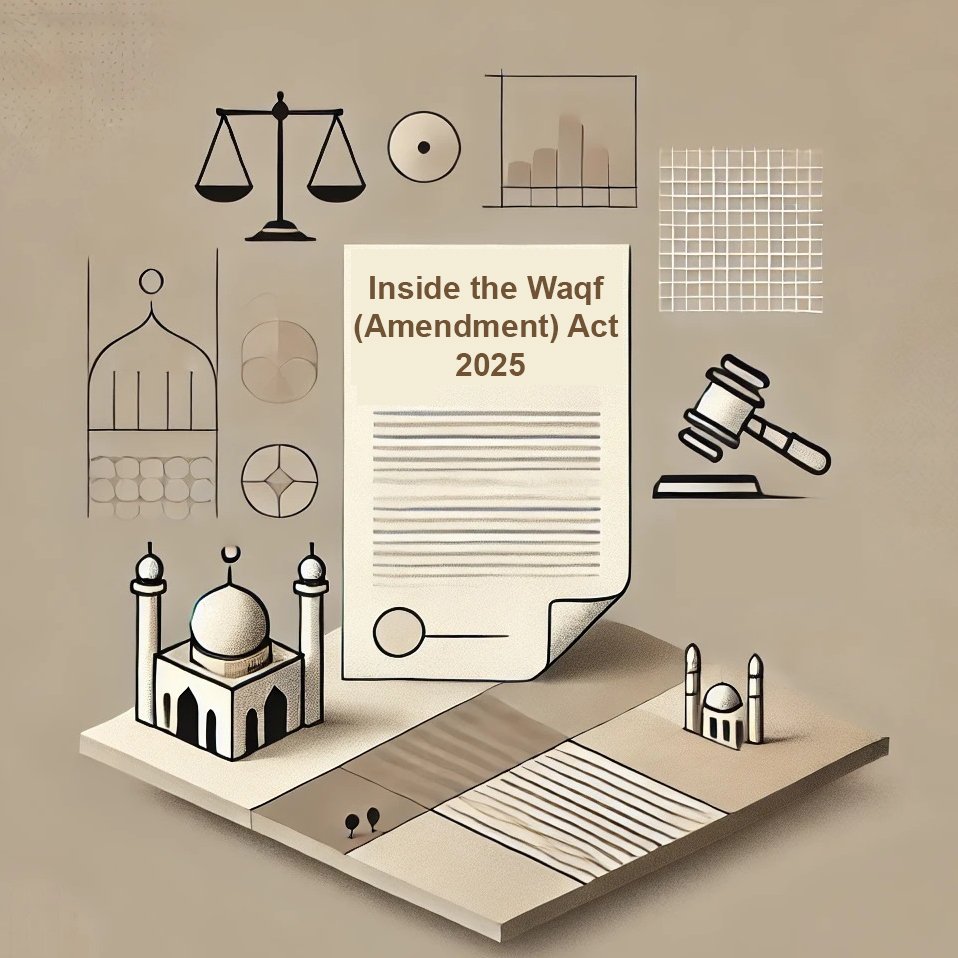
Imagine having over 10 lakh acres of land at your disposal and barely earning enough to cover annual upkeep. Now imagine that land was meant to fund schools, hospitals, orphanages, and help millions of poor families. That is the story of India’s Waqf properties, and it is why the Waqf (Amendment) Act, 2025 has sparked a national firestorm.
The government claims it is cleaning up a legacy of mismanagement. Critics argue it threatens religious autonomy and facilitates bureaucratic control.
So, what’s really happening?
What is the Waqf (Amendment) Act, 2025?
The Act amends the Waqf Act of 1995, which governs Islamic charitable endowments known as Waqf. These properties are legally protected assets intended for public good—mosques, schools, hospitals, graveyards, and other social purposes.
Key provisions in the amendment include:
- Appointment of non-Muslim members to Waqf Boards.
- Empowering District Collectors to resolve disputes over Waqf land.
- Removal of the “Waqf by User” clause that allowed properties in continuous religious use without documents to be treated as Waqf.
- Application of the Limitation Act, 1963, which restricts the ability of Waqf Boards to reclaim old encroachments.
Why Was the Amendment Deemed Necessary?
One of the core arguments behind the amendment is the long-standing underutilization and mismanagement of Waqf properties.
According to the Sachar Committee Report (2006) and the Joint Parliamentary Committee on Waqf (2011):
- There are over 8.72 lakh Waqf properties in India.
- The estimated land area exceeds 6 to 10 lakh acres.
- Annual revenue generated was merely ₹163 crore, a return of less than 0.1% on the total asset value.
The reasons behind such dismal returns include rampant encroachments, poor administration, obsolete leasing arrangements, and a lack of digital or financial transparency. Many Waqf lands are leased out at outdated rates like ₹100 per month and subleased to commercial entities. Encroachments account for a large chunk of land loss, and records are often incomplete or forged.
Despite the charitable mandate of Waqf in Islamic law, very few institutions like hospitals, orphanages, or schools have been built using these properties. Less than 5% of properties are reported to have any active role in public welfare.
Corruption Inside Waqf Boards
Several corruption scandals have plagued Waqf institutions across the country. These include illegal land sales, fraudulent leases, tampering with ownership documents, and complicity with land mafias.
For example, a 2023 RTI revealed that in Delhi, only 3 out of 1900 Waqf properties were being used for charitable or public service purposes. The Karnataka Waqf Scam, exposed in 2021, involved land misappropriation worth ₹2 lakh crore, showcasing the scale of exploitation.
The lack of standardized audit practices, no professional asset management, and political interference in appointments have all contributed to the systemic failure of Waqf Boards to fulfill their objectives.
Why Are Critics Opposing the Amendment?
Despite valid concerns about corruption, the amendment has drawn strong opposition from community leaders, civil society, and opposition parties.
One major criticism is that the Act infringes upon religious autonomy. The inclusion of non-Muslims on Waqf Boards is seen as a violation of Article 26 of the Constitution, which grants religious denominations the right to manage their own affairs.
Another point of contention is the removal of the “Waqf by User” clause. Many properties—especially centuries-old mosques and graveyards—have no formal documentation but have been in uninterrupted religious use. Critics fear these could now lose their Waqf status and become vulnerable to acquisition.
The application of the Limitation Act, 1963, is also seen as deeply problematic. It restricts Waqf Boards from reclaiming properties that have been encroached for more than 12 years, essentially legitimizing illegal occupations.
By giving District Collectors more authority, critics argue that the government is centralizing control over religious institutions, undermining community-led management. This raises concerns of political misuse and further marginalization of minority voices.
Legal and Political Repercussions
The amendment has already been challenged in the Supreme Court by Congress MP Mohammad Jawed, AIMIM leader Asaduddin Owaisi, and others. These petitions argue that the Act is unconstitutional and targets the Muslim community’s religious freedom.
Politically, the BJP has defended the Act as a transparency measure. The opposition, including Congress, AIMIM, and CPI(M), sees it as part of a broader pattern of infringing on minority rights.
Protests and Public Reaction
The public backlash has been intense. In West Bengal’s Murshidabad district, protests turned violent, resulting in deaths and dozens of arrests. The All India Muslim Personal Law Board has announced a nationwide agitation plan.
Meanwhile, civil rights groups have warned that the Act could lead to cultural and religious disempowerment if implemented without adequate safeguards.
The Way Forward
While almost all stakeholders agree that Waqf Boards need reform, the method and intent are under question. What is needed is a transparent, community-led mechanism to revive and utilize these properties for genuine public welfare.
Digital audits, professional asset management, regular financial scrutiny, and capacity-building are essential. Simultaneously, any reform must uphold the spirit of religious freedom and ensure that historical properties are not lost due to bureaucratic oversight.
The Waqf (Amendment) Act, 2025 has exposed deep cracks in India’s religious trust management system. The challenge is to repair it without destroying the values it was meant to uphold.
Sources:
- Justice Sachar Committee Report (2006) – Ministry of Minority Affairs
- PRS India: Waqf Amendment Bill Summary
- Press Information Bureau (PIB)
- The Hindu
- Indian Express
- The Wire
- Hindustan Times


